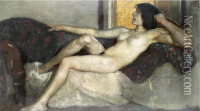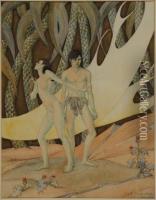Eric Harald Macbeth Robertson Paintings
Eric Harald Macbeth Robertson, born in 1907, was a Scottish painter known for his distinctive style that often incorporated elements of surrealism and symbolism. While not as widely recognized as some of his contemporaries, Robertson's work made a notable contribution to the British art scene, particularly in the early to mid-20th century.
Robertson's early life and education played a significant role in shaping his artistic direction. He studied at the Slade School of Fine Art in London, which was a leading institution for art education, known for nurturing the talents of many prominent British artists. His time at the Slade would have provided him with a solid foundation in classical art techniques, as well as exposure to the vibrant and evolving art world of the time.
Throughout his career, Robertson exhibited a penchant for the imaginative and the mystical. His paintings often featured dream-like landscapes, enigmatic figures, and a rich palette that conveyed a sense of otherworldliness. Robertson's work, while unique, can be seen as part of a broader European tradition of fantastical art, sharing sensibilities with artists like Giorgio de Chirico and even the early surrealists.
Despite the intriguing qualities of his work, Eric Harald Macbeth Robertson remains a relatively obscure figure in art history. His career was undoubtedly affected by the historical context in which he lived, including the economic challenges of the Great Depression and the disruption of the art world during World War II. Nevertheless, those who have studied his oeuvre often appreciate his imaginative approach and his skillful blending of reality and fantasy.
Eric Harald Macbeth Robertson passed away in 1964, leaving behind a modest but compelling body of work. While he may not have achieved the fame of some of his peers, his contributions to the field of British art continue to be recognized by scholars and collectors who are drawn to his unique vision and artistic legacy.



